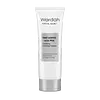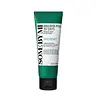What's inside
What's inside
 Key Ingredients
Key Ingredients

 Benefits
Benefits

 Concerns
Concerns

 Ingredients Side-by-side
Ingredients Side-by-side

Water
Skin ConditioningGlycerin
HumectantAcrylates Copolymer
Cocamidopropyl Betaine
CleansingPropylene Glycol
HumectantSodium Laureth Sulfate
CleansingPotassium Cocoyl Glycinate
Decyl Glucoside
CleansingSodium Lauroyl Methyl Isethionate
CleansingSodium PCA
HumectantPotassium Cocoate
EmulsifyingSodium Chloride
MaskingPhenoxyethanol
PreservativeSodium Hydroxide
BufferingParfum
MaskingDMDM Hydantoin
PreservativeGluconolactone
Skin ConditioningZea Mays Starch
AbsorbentMannitol
HumectantMicrocrystalline Cellulose
AbsorbentEthylhexylglycerin
Skin ConditioningDisodium EDTA
Trisodium Ethylenediamine Disuccinate
Sodium Benzoate
MaskingLactic Acid
BufferingGlycolic Acid
BufferingMica
Cosmetic ColorantCitric Acid
BufferingCitrus Aurantium Dulcis Fruit Extract
MaskingHydroxypropyl Starch Phosphate
Tocopheryl Acetate
AntioxidantLeontopodium Alpinum Extract
Skin ConditioningMalic Acid
BufferingSaccharum Officinarum Extract
MoisturisingTartaric Acid
BufferingPotassium Sorbate
PreservativeAcer Saccharum Extract
Skin ConditioningCitrus Limon Fruit Extract
MaskingVaccinium Myrtillus Fruit Extract
Skin ConditioningCI 77891
Cosmetic ColorantCI 77499
Cosmetic ColorantWater, Glycerin, Acrylates Copolymer, Cocamidopropyl Betaine, Propylene Glycol, Sodium Laureth Sulfate, Potassium Cocoyl Glycinate, Decyl Glucoside, Sodium Lauroyl Methyl Isethionate, Sodium PCA, Potassium Cocoate, Sodium Chloride, Phenoxyethanol, Sodium Hydroxide, Parfum, DMDM Hydantoin, Gluconolactone, Zea Mays Starch, Mannitol, Microcrystalline Cellulose, Ethylhexylglycerin, Disodium EDTA, Trisodium Ethylenediamine Disuccinate, Sodium Benzoate, Lactic Acid, Glycolic Acid, Mica, Citric Acid, Citrus Aurantium Dulcis Fruit Extract, Hydroxypropyl Starch Phosphate, Tocopheryl Acetate, Leontopodium Alpinum Extract, Malic Acid, Saccharum Officinarum Extract, Tartaric Acid, Potassium Sorbate, Acer Saccharum Extract, Citrus Limon Fruit Extract, Vaccinium Myrtillus Fruit Extract, CI 77891, CI 77499
Water
Skin ConditioningGlycerin
HumectantCentella Asiatica Extract
CleansingPalmitic Acid
EmollientStearic Acid
CleansingLauric Acid
CleansingMyristic Acid
CleansingPotassium Hydroxide
BufferingLauryl Betaine
CleansingButylene Glycol
HumectantPEG-100 Stearate
Glyceryl Stearate
EmollientBeeswax
Emulsion StabilisingMelaleuca Alternifolia Leaf Water
AntimicrobialSodium Methyl Cocoyl Taurate
CleansingPotassium Cocoyl Glycinate
Salicylic Acid
MaskingDipropylene Glycol
HumectantSodium Chloride
MaskingHydroxyacetophenone
AntioxidantMentha Piperita Oil
MaskingCaprylyl Glycol
Emollient1,2-Hexanediol
Skin ConditioningDisodium EDTA
Hydroxyethylcellulose
Emulsion StabilisingCalamine
AbsorbentGluconolactone
Skin ConditioningCitric Acid
BufferingPotassium Glycyrrhizinate
Skin ConditioningArtemisia Vulgaris Extract
Skin ConditioningMadecassoside
AntioxidantAsiaticoside
AntioxidantAsiatic Acid
Skin ConditioningMadecassic Acid
Skin ConditioningWater, Glycerin, Centella Asiatica Extract, Palmitic Acid, Stearic Acid, Lauric Acid, Myristic Acid, Potassium Hydroxide, Lauryl Betaine, Butylene Glycol, PEG-100 Stearate, Glyceryl Stearate, Beeswax, Melaleuca Alternifolia Leaf Water, Sodium Methyl Cocoyl Taurate, Potassium Cocoyl Glycinate, Salicylic Acid, Dipropylene Glycol, Sodium Chloride, Hydroxyacetophenone, Mentha Piperita Oil, Caprylyl Glycol, 1,2-Hexanediol, Disodium EDTA, Hydroxyethylcellulose, Calamine, Gluconolactone, Citric Acid, Potassium Glycyrrhizinate, Artemisia Vulgaris Extract, Madecassoside, Asiaticoside, Asiatic Acid, Madecassic Acid
 Reviews
Reviews

Ingredients Explained
These ingredients are found in both products.
Ingredients higher up in an ingredient list are typically present in a larger amount.
Citric Acid is an alpha hydroxy acid (AHA) naturally found in citrus fruits like oranges, lemons, and limes.
Like other AHAs, citric acid can exfoliate skin by breaking down the bonds that hold dead skin cells together. This helps reveal smoother and brighter skin underneath.
However, this exfoliating effect only happens at high concentrations (20%) which can be hard to find in cosmetic products.
Due to this, citric acid is usually included in small amounts as a pH adjuster. This helps keep products slightly more acidic and compatible with skin's natural pH.
In skincare formulas, citric acid can:
While it can provide some skin benefits, research shows lactic acid and glycolic acid are generally more effective and less irritating exfoliants.
Most citric acid used in skincare today is made by fermenting sugars (usually from molasses). This synthetic version is identical to the natural citrus form but easier to stabilize and use in formulations.
Read more about some other popular AHA's here:
Learn more about Citric AcidDisodium EDTA plays a role in making products more stable by aiding other preservatives.
It is a chelating agent, meaning it neutralizes metal ions that may be found in a product.
Disodium EDTA is a salt of edetic acid and is found to be safe in cosmetic ingredients.
Learn more about Disodium EDTAGluconolactone is a PHA. PHAs are a great gentle alternative to traditional AHAs.
When applied, Gluconolactone has the same affect on skin as AHAs such as lactic acid. It helps dissolve the dead skin cells in the top layer of your skin. This improves texture and brightens the skin.
PHAs are more gentle than AHAs due to their larger structure. They do not penetrate as deeply as AHAs and take a longer time to dissolve dead cells. Studies show PHAs do not cause as much irritation.
Gluconolactone has some interesting properties:
In a 2004 study, Gluconolactone was found to prevent UV damage in mouse skin cells and has not been found to increase sun sensitivity. However, we still recommend wearing SPF daily.
This ingredient is is an created by reacting gluconic acid with an alcohol.
Learn more about GluconolactoneGlycerin is already naturally found in your skin. It helps moisturize and protect your skin.
A study from 2016 found glycerin to be more effective as a humectant than AHAs and hyaluronic acid.
As a humectant, it helps the skin stay hydrated by pulling moisture to your skin. The low molecular weight of glycerin allows it to pull moisture into the deeper layers of your skin.
Hydrated skin improves your skin barrier; Your skin barrier helps protect against irritants and bacteria.
Glycerin has also been found to have antimicrobial and antiviral properties. Due to these properties, glycerin is often used in wound and burn treatments.
In cosmetics, glycerin is usually derived from plants such as soybean or palm. However, it can also be sourced from animals, such as tallow or animal fat.
This ingredient is organic, colorless, odorless, and non-toxic.
Glycerin is the name for this ingredient in American English. British English uses Glycerol/Glycerine.
Learn more about GlycerinPotassium Cocoyl Glycinate is an amino acid-based surfactant and cleaning agent. This ingredient can be derived from animals or plants. It may also be synthetically created from fatty acids of the coconut and glycine.
Potassium Cocoyl Glycinate is a gentle surfactant. Surfactants help gather the dirt, oil, and other pollutants from your skin to be rinsed away. It is a mild cleanser and naturally produces foam.
Chances are, you eat sodium chloride every day. Sodium Chloride is also known as table salt.
This ingredient has many purposes in skincare: thickener, emulsifier, and exfoliator.
You'll most likely find this ingredient in cleansers where it is used to create a gel-like texture. As an emulsifier, it also prevents ingredients from separating.
There is much debate on whether this ingredient is comedogenic. The short answer - comedogenic ratings don't tell the whole story. Learn more about comegodenic ratings here.
The concensus about this ingredient causing acne seems to be divided. Research is needed to understand if this ingredient does cause acne.
Scrubs may use salt as the primary exfoliating ingredient.
Learn more about Sodium ChlorideWater. It's the most common cosmetic ingredient of all. You'll usually see it at the top of ingredient lists, meaning that it makes up the largest part of the product.
So why is it so popular? Water most often acts as a solvent - this means that it helps dissolve other ingredients into the formulation.
You'll also recognize water as that liquid we all need to stay alive. If you see this, drink a glass of water. Stay hydrated!
Learn more about Water